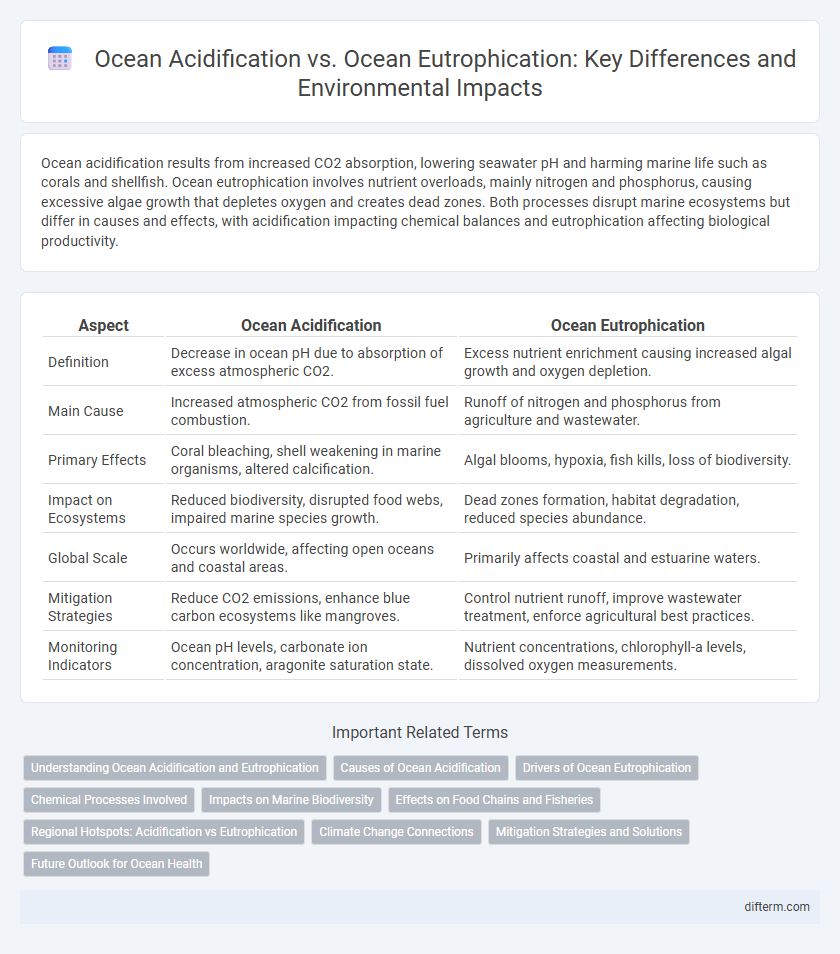Ocean acidification results from increased CO2 absorption, lowering seawater pH and harming marine life such as corals and shellfish. Ocean eutrophication involves nutrient overloads, mainly nitrogen and phosphorus, causing excessive algae growth that depletes oxygen and creates dead zones. Both processes disrupt marine ecosystems but differ in causes and effects, with acidification impacting chemical balances and eutrophication affecting biological productivity.
Table of Comparison
| Aspect | Ocean Acidification | Ocean Eutrophication |
|---|---|---|
| Definition | Decrease in ocean pH due to absorption of excess atmospheric CO2. | Excess nutrient enrichment causing increased algal growth and oxygen depletion. |
| Main Cause | Increased atmospheric CO2 from fossil fuel combustion. | Runoff of nitrogen and phosphorus from agriculture and wastewater. |
| Primary Effects | Coral bleaching, shell weakening in marine organisms, altered calcification. | Algal blooms, hypoxia, fish kills, loss of biodiversity. |
| Impact on Ecosystems | Reduced biodiversity, disrupted food webs, impaired marine species growth. | Dead zones formation, habitat degradation, reduced species abundance. |
| Global Scale | Occurs worldwide, affecting open oceans and coastal areas. | Primarily affects coastal and estuarine waters. |
| Mitigation Strategies | Reduce CO2 emissions, enhance blue carbon ecosystems like mangroves. | Control nutrient runoff, improve wastewater treatment, enforce agricultural best practices. |
| Monitoring Indicators | Ocean pH levels, carbonate ion concentration, aragonite saturation state. | Nutrient concentrations, chlorophyll-a levels, dissolved oxygen measurements. |
Understanding Ocean Acidification and Eutrophication
Ocean acidification results from increased atmospheric CO2 dissolving into seawater, lowering pH levels and threatening marine life such as corals and shellfish. Ocean eutrophication occurs due to excess nutrient input, primarily nitrogen and phosphorus, fueling harmful algal blooms that deplete oxygen and create dead zones. Understanding both processes is crucial for managing marine ecosystems and mitigating biodiversity loss linked to human activities.
Causes of Ocean Acidification
Ocean acidification is primarily caused by the absorption of excess atmospheric carbon dioxide (CO2) resulting from the burning of fossil fuels and deforestation, which leads to a decrease in seawater pH. Unlike ocean eutrophication, driven mainly by nutrient pollution from agricultural runoff and wastewater discharge, ocean acidification stems from global carbon cycle disruptions. This increased CO2 dissolves in the ocean, forming carbonic acid that alters marine chemical balance and affects calcifying organisms.
Drivers of Ocean Eutrophication
Nutrient over-enrichment from agricultural runoff, sewage discharge, and industrial effluents constitutes the primary driver of ocean eutrophication, promoting excessive algal blooms that deplete oxygen levels in marine ecosystems. Elevated nitrogen and phosphorus inputs disrupt natural marine biogeochemical cycles, leading to hypoxic or anoxic conditions harmful to fish, coral reefs, and biodiversity. Unlike ocean acidification caused by increased atmospheric CO2 absorption, eutrophication stems from localized anthropogenic nutrient loading that severely impacts coastal water quality and marine life sustainability.
Chemical Processes Involved
Ocean acidification occurs when increased carbon dioxide (CO2) dissolves in seawater, forming carbonic acid that lowers pH and disrupts carbonate ion availability essential for marine organisms. Ocean eutrophication results from excessive nutrient inputs, primarily nitrogen and phosphorus, triggering algal blooms that deplete oxygen through microbial decomposition and alter water chemistry. Both processes involve chemical shifts that critically affect marine ecosystems but differ in their driving reactions: acid-base equilibria in acidification versus nutrient-driven biochemical oxygen demand in eutrophication.
Impacts on Marine Biodiversity
Ocean acidification significantly reduces carbonate ion availability, impairing shell and skeleton formation in marine organisms like corals, mollusks, and some plankton, leading to habitat loss and decreased biodiversity. Ocean eutrophication increases nutrient levels, causing algal blooms that create hypoxic zones, resulting in widespread marine life mortality and altered species composition. Both processes disrupt ecosystem balance, threaten key species, and reduce overall marine biodiversity resilience.
Effects on Food Chains and Fisheries
Ocean acidification disrupts calcium carbonate formation in marine organisms, weakening coral reefs and shellfish populations essential for diverse food chains. Ocean eutrophication causes algal blooms that lead to hypoxic zones, drastically reducing fish stocks and altering predator-prey dynamics. Both processes threaten fisheries by decreasing biodiversity and impacting the stability of marine ecosystems critical for commercial and subsistence fishing.
Regional Hotspots: Acidification vs Eutrophication
Ocean acidification hotspots are predominantly found in polar and upwelling regions where cold waters absorb higher levels of CO2, leading to decreased pH and threats to calcifying marine species. In contrast, ocean eutrophication hotspots occur mainly in coastal areas with excessive nutrient runoff from agriculture and urbanization, causing harmful algal blooms and oxygen-depleted dead zones. Both phenomena pose significant regional ecological risks but differ in their drivers, spatial distribution, and impacts on marine biodiversity.
Climate Change Connections
Ocean acidification results from increased CO2 absorption, lowering seawater pH and disrupting marine life such as coral reefs and shellfish. Ocean eutrophication, driven by nutrient runoff, causes excessive algal blooms that deplete oxygen and release greenhouse gases like nitrous oxide, exacerbating climate change. Both processes intensify climate feedback loops, threatening biodiversity and ocean ecosystem resilience.
Mitigation Strategies and Solutions
Mitigation strategies for ocean acidification focus on reducing carbon dioxide emissions through transitioning to renewable energy sources and enhancing carbon sequestration via marine protected areas and blue carbon ecosystems like mangroves and seagrasses. Ocean eutrophication solutions involve controlling nutrient runoff from agriculture by implementing precision fertilization, promoting sustainable farming practices, and restoring wetlands to filter excess nitrogen and phosphorus before reaching coastal waters. Both challenges benefit from integrated watershed management and enhanced monitoring systems to track changes and enforce environmental regulations effectively.
Future Outlook for Ocean Health
Ocean acidification, driven by increased CO2 absorption, threatens marine biodiversity by impairing calcifying organisms essential for ecosystem balance. Ocean eutrophication, fueled by nutrient runoff from agriculture and wastewater, leads to hypoxic zones that disrupt aquatic life and fisheries productivity. Future ocean health depends on mitigating greenhouse gas emissions and nutrient pollution through global policy enforcement and innovative marine conservation strategies.
ocean acidification vs ocean eutrophication Infographic

 difterm.com
difterm.com